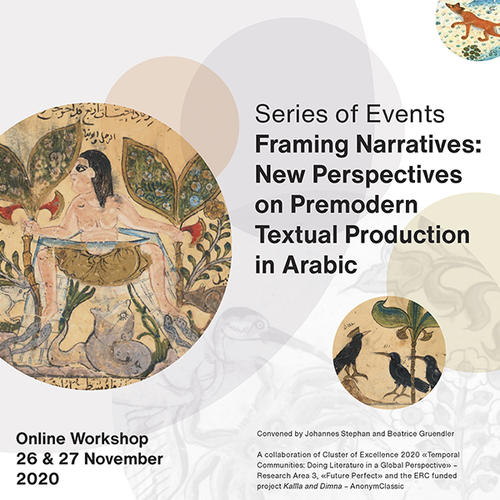Framing Narratives
framing
Image Credit: BNF Arabe 3465 https://gallica.bnf.fr/ark:/12148/btv1b84229611,Topkapı Palace Library. MS R. 1022
Johannes Stephan
A frame narrative is more than an elegant narrative form. For the act of narrative framing is a means to present and contextualize human oral and written communication. Middle Eastern frame narratives have often served both as models for other literary projects – premodern and modern – and as a point of departure for analytical concepts in literary theory. Through a transdisciplinary reading group, a series of events on the topic together with the EXC 2020 Temporal Communities at FU Berlin and international colleagues, AnonymClassic researchers recontextualize The Book of Kalīla wa-Dimna within the traditions of frame narratives and world literature.
In literary theory, the Arabic tradition serves as the most popular example for frame narratives – which is a concept that emerged in modern European scholarship only during the beginning of the 19th century. Besides the well-known Arabian Nights, notably through its European reception, many other frame narratives have passed from various languages into and through Arabic, among them the 101 Nights, the Book of Sindbad, and Kalīla wa-Dimna in the tradition of Ibn al-Muqaffaʿ (d. 759 AD).
Existing in over 140 manuscript copies in Arabic from the 13th to 19th centuries and numerous translations into adjacent linguistic traditions – Persian, Syriac, Greek, and Hebrew –, Kalīla wa-Dimna figures among the most widespread frame narratives in world literature. Its textual structure is conspicuous, as the book does not solely contain a story-within-a-story-principle. Among other things, it contains a number of prefaces, of which some do also frame parables and allegories. Furthermore, over the long history of Kalīla wa-Dimna in different literary traditions the framework of the book changed: Prefaces, some embedded stories and book chapters have been added, in some versions textual parts have been removed. Analyzing the complex structure of the book leads to questions regarding the modern concept of narrative framing and its application to such premodern textual traditions.
Since the framing of narrative works can be of a diverse nature –stories and storytelling, digressions, paratexts, and supplements – the thematic scope of our activities is not confined to a specific genre. Emphasizing the activity of “framing” instead of the more stable epithet “frame,” our activities discuss narrative and non-narrative intratextual and intertextual interactions in the fields of premodern Arabic, Hebrew, Syriac, and Persian literatures as well as modern literary traditions.
In the Literary Theory reading group, we mainly concentrate on contemporary literary theory but also look at the diverse material that our group members study: From Arabic anthological works, and classical rhetoric to Tunisian and Indian novels and W. Benjamin’s Arcades project. Under the keyword framing narratives, reading group members will contribute to a joint online publication in the Living Handbook of Temporal Communities.
Besides, AnonymClassic member Johannes Stephan, in close collaboration with the EXC 2020 Temporal Communities (Research Area 3) under moderation of Beatrice Gruendler, organized a series of events:
- an online keynote by Ulrich Marzolph, on November 25, 2020: “The Frame Tale: Potentials and Limitations,” followed by
- an online workshop on November 26 & 27, 2020,
- an international conference on November 18 & 19, 2021 under the title “Framing Narratives. New Perspectives on Premodern Textual Production (in Arabic and adjacent traditions),” including
- an afternoon online keynote on November 18, by Said Yaktine in Arabic (Université Mohammed V de Rabat): “The Frame Story and the Narrative Response in Kalīla wa-Dimna,” and
- an evening lecture by Temporal Communities senior fellow (November 2021) Pegah Shahbaz: “Ruse and Guile in Classical Persian Prose Narratives – The Indian Heritage” on November 23, 2021.
Read the press release to the series of events here.


